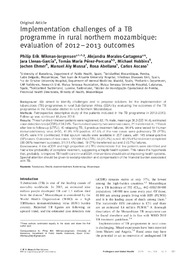Por favor, use este identificador para citar o enlazar este ítem:
https://hdl.handle.net/11000/35251Registro completo de metadatos
| Campo DC | Valor | Lengua/Idioma |
|---|---|---|
| dc.contributor.author | Wikman-Jorgensen, Philip Erick | - |
| dc.contributor.author | Morales-Cartagena, Alejandra | - |
| dc.contributor.author | Llenas-García, Jara | - |
| dc.contributor.author | Perez-Porcuna, Tomas Maria | - |
| dc.contributor.author | Hobbins, Michael | - |
| dc.contributor.author | Ehmer, Jochen | - |
| dc.contributor.author | Aly Mussa, Manuel | - |
| dc.contributor.author | Abellana, Rosa | - |
| dc.contributor.author | Ascaso, Carlos | - |
| dc.contributor.other | Departamentos de la UMH::Medicina Clínica | es_ES |
| dc.date.accessioned | 2025-01-24T13:12:55Z | - |
| dc.date.available | 2025-01-24T13:12:55Z | - |
| dc.date.created | 2015-07 | - |
| dc.identifier.citation | Pathog Glob Health . 2015 Jul;109(5):221-7 | es_ES |
| dc.identifier.issn | 2047-7724 | - |
| dc.identifier.uri | https://hdl.handle.net/11000/35251 | - |
| dc.description.abstract | Background: We aimed to identify challenges and to propose solutions for the implementation of tuberculosis (TB) programmes in rural Sub-Saharan Africa (SSA) by evaluating the outcomes of the TB programme in the Ancuabe district in rural Northern Mozambique. Methods: Retrospective descriptive study of the patients included in the TB programme in 2012–2013. Follow-up was continued till June 2014. Results: Three hundred nineteen patients were registered, 62.1% male, mean age 36.3 (SD 14.4), estimated case detection rate (eCDR) of 24.24%. Two hundred seventy-two were new cases, 21 transferred-in, 11 back after lost to follow-up (LTFU), 10 relapsing TB, 5 previous treatment failures. 94.4% were tested for Human immunodeficiency virus (HIV), 41.9% HIV-positive. 87.5% of the new cases were pulmonary TB (PTB), 43.4% were HIV co-infected. Initial sputum results were available in 207 cases, with 145 smear-positive (SP) cases. Outcomes of new cases: 122 (44.9%) LTFU, 55 (20.2%) cured, 43 (15.8%) treatment completed (98–36%-treatment success), 31 (11.4%) died, 19 (7%) transferred out and 2 (0.7%) failures. Conclusions: A low eCDR and high proportion of LTFU demonstrate that few patients were identified and had a low probability of complete treatment, suggesting a fragile health system. This raises the hypothesis that, probably, to improve TB health care in rural SSA, interventions should aim at improving health systems. Special attention should be given to social protection and compensation of the financial burden associated with TB. | es_ES |
| dc.format | application/pdf | es_ES |
| dc.format.extent | 7 | es_ES |
| dc.language.iso | eng | es_ES |
| dc.publisher | Taylor&Francis | es_ES |
| dc.rights | info:eu-repo/semantics/openAccess | es_ES |
| dc.rights | Attribution-NonCommercial-NoDerivatives 4.0 Internacional | * |
| dc.rights.uri | http://creativecommons.org/licenses/by-nc-nd/4.0/ | * |
| dc.subject | tuberculosis | es_ES |
| dc.subject | directly observed treatment | es_ES |
| dc.subject | epidemiology | es_ES |
| dc.subject | mozambique | es_ES |
| dc.title | Implementation challenges of a TB programme in rural northern mozambique: evaluation of 2012–2013 outcomes | es_ES |
| dc.type | info:eu-repo/semantics/article | es_ES |
| dc.relation.publisherversion | 10.1179/2047773215Y.0000000027 | es_ES |

Ver/Abrir:
Implementation challenges of a TB.pdf
205,73 kB
Adobe PDF
Compartir:
 La licencia se describe como: Atribución-NonComercial-NoDerivada 4.0 Internacional.
La licencia se describe como: Atribución-NonComercial-NoDerivada 4.0 Internacional.
.png)